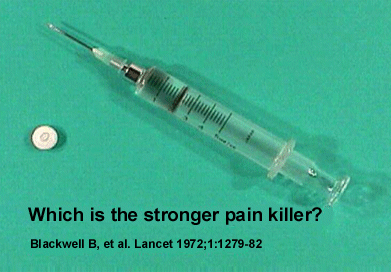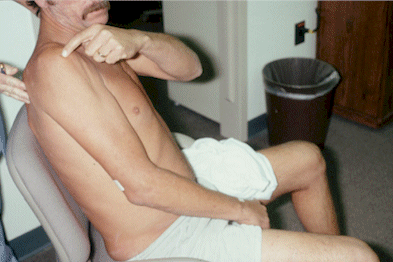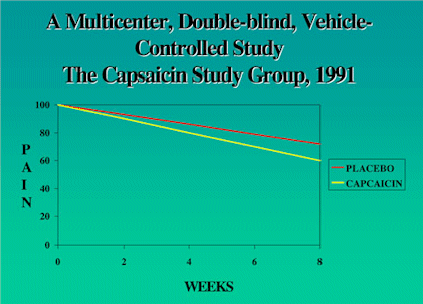How to Determine the Effectiveness of Treatments for RSD/CRPS
Dr. Anthony F. Kirkpatrick,
Chairman, Scientific Advisory Committee
The first thing that should be understood about treating any medical condition is there are three things that can lead to improvement in the condition: - Natural History of the Disease
- Placebo or Nonspecific Effects of Treatment
- Specific Effects of Treatment
The natural history of a disease can be highly variable. A headache comes and goes, as does a backache. Similarly, the symptoms of RSD can come and go, especially in children. Many adults who have RSD report that the pain tends to be there constantly, but the level of pain and symptoms goes up and down. Thus the natural course of the disease can in itself lead to temporary improvement in the medical condition. When being treated for RSD, you need to be able to separate what would happen anyway, from what is being caused by the treatment. Figure 1 illustrates what is typical for RSD. The pain goes along, then there is an exacerbation of symptoms, it reaches a plateau or peak and then comes down on its own without any treatment at all. The patient seems to be on a roller coaster ride, but the pain is always present at some level in most patients. One of the things that seems predictable is when there is an acute exacerbation of a disease (whether it be a headache, low back pain or RSD), there is a tendency for the doctor to treat the disease at that point in time. But, this is when the symptoms of a disease might decrease without treatment. Therefore, when the symptoms of a disease fluctuate, the doctor may take undue credit for the improvement following his or her treatment.
Similarly, symptoms way worsen once treatment has begun, even with an effective treatment. The doctor may be blamed unfairly for a bad outcome following his or her treatment. There are many factors that go into the doctor-patient relationship, but too often the patient classifies their treatment as a failure and start doctor shopping. This often results in patients dismissing traditional medicine and adopting less conventional treatment.
Because the symptoms of RSD fluctuate, the Clinical Practice Guidelines for RSD recommend that patients be offered a "series" of 1-3 sympathetic blocks.
With a series of sympathetic blocks, the patient has a better chance of determining the true causes of improvement or worsening of symptoms after treatment in the context of a disease where there are spontaneous fluctuations in symptoms.
FIGURE 1

The placebo effect is due to "treatments," which have no real physiological or pharmacological property, that affect the disease process. We call the placebo response to treatment a nonspecific effect. For example, treatment with inactive "sugar pills" can improve a patient's condition. The patient needs to be able to separate the placebo effect from the specific effects due to the pharmacological or physiological action of the treatment on the natural history of a disease. Medical insurance companies and other third party payers are interested in paying for treatments that really have a pharmacological or physiological effect on the body. They do not want pay for placebos. Everyone should be aware and not wish to waste resources on these treatments.
The response rate to placebos may vary depending on the circumstances. Virtually anyone can respond to a placebo if the conditions are right. Furthermore, the effects of the placebo can be profound, resulting in 100% relief of pain in some cases.
Many factors can influence the magnitude of the placebo response: - Anxiety
- Expectation
- Prestige of the doctor
- Cost and invasiveness of the treatment
The more anxious you are, the stronger your response to a placebo, especially when the symptom is pain. 1 Patient expectation is also an important factor. For example, one study looked at patient expectation as a factor in treating a potentially life-threatening symptom that causes difficulty in breathing in asthmatic patients. 2 The life-threatening symptom is called bronchospasm. The researchers found that when patients were told they would receive either an inactive drug (placebo) or an active drug for asthma, the placebo caused little relief of bronchospasm. On the other hand, if the researchers told the patients they were comparing two "drugs" to determine which drug was more effective against bronchospasm, the placebo (inactive drug) had a much greater effect in relieving the symptom of bronchospasm, than if the patients were told one of the drugs was inactive. In other words, if the patient had the expectation that the placebo drug had some pharmacological action on asthma, the placebo effect had a positive effect, even possibly saving a life by decreasing in airway resistance due to bronchospasm. The friendliness, sympathy, empathy, and prestige of the doctor can also enhance the beneficial effects of the placebo on the patient's medical condition. 3,4
The expectation associated with a more invasive or costly treatment can also enhance the placebo effect. 5 For example, take a look at the pill and syringe in Figure 2. Both contain the same amount of pain killer (an opioid narcotic). Which one of these is the much stronger pain killer? The answer is obvious. Doctors can legitimately take advantage of this placebo effect when sedating patients for various procedures to treat RSD,such as sympathetic nerve blocks. The doctor may want the patient to "see" them give the pain killer with a syringe in the patient's IV. They may also want to "tell" the patient they are injecting a "narcotic." The doctor is not deceiving the patient because he is telling the truth. The doctor knows the placebo effect can be effective in relieving pain. The placebo effect can decrease the amount of narcotic required for the procedure and thereby minimize the narcotic's side effects, such as poor breathing (hypoventilation) during the procedure.
FIGURE 2

Even the color of a placebo pill can determine the nature of its effect on disease. For example, white pills are more effective in treating pain than yellow pills. On the other hand, yellow pills are more effective than white pills in treating depression. 6 Also, there can be a dose response to placebos where two placebo pills are more effective than one placebo pill. 5
It is a mistake to believe that placebos cannot hurt you. In many studies patients demonstrate side effects to placebos. On average, 20% of patients have side effects from placebos that impact significantly on their quality of life. These side effects include drowsiness, headaches, nervousness, insomnia, nausea, constipation. 7
Surgeries can have profound placebo effects. Back in the late 1950s, two well-controlled studies (i.e., double-blind randomized trials) woke us up to this reality. 8,9 Back then, it was believed that tying off (ligating) the arteries in the chest wall would divert blood from the muscle in the chest wall into the heart and help relieve chest pain due to a heart condition called angina. The surgery was called internal mammary artery ligation. The results were astounding. Some patients were getting profound relief of their chest pain and improvement in their exercise tolerance following this surgery. Some patients were getting out of bed for the first time. Furthermore, some patients had relief of their chest pain lasting for over a year. However, some surgeons thought that a control study should be performed to rule out the placebo effect. Two studies were performed where an incision was made in the chest wall but the blood vessels were not tied off (a sham operation). Guess what? They got the same results as when the arteries were tied off. These results made it clear that surgery can have a potent placebo effect.
Given that the placebo can have positive effects on disease, why not intentionally deceive the patient with inactive treatments? - Deliberately deceiving the patient will severely undercut the doctor-patient relationship. If a doctor promotes a particular treatment, and the patient learns the doctor did not know whether the treatment was effective, the patient may feel cheated by the doctor. The patient may feel even greater resentment toward the doctor if they suffer a serious complication from a treatment with questionable effectiveness.
- As discussed, the placebo effect can have significant adverse effects that impact on the quality of life.
- The patient who is told the drug is expected to work, but it doesn't work in their particular case, may be harmed by the fact that they are provoked into believing their disease is much worse than it really is. A negative prognosis provoked under these circumstances may cause unnecessary anxiety in the patient.
- It is clear some patients with RSD respond differently or not at all to the same drugs. A good example is the use of various antidepressants to treat RSD. If the doctor tells the patient they should respond to the drug (in order to enhance the placebo effect), and they do not, you can have what's called a negative carry over placebo effect, so that any other treatment, even if effective, may not work as well.
For all of these reasons, doctors should not deliberately deceive patients with inactive treatments in an effort to enhance the positive effects of the placebo. There are four ways to help determine the effectiveness of treatments for RSD: - Education: The first thing you can do is educate yourself about the natural history of RSD and the importance of the placebo effect.
- Monitor Response: The placebo effect over time tends to be less effectiveness and shorter in duration with each repeat of the treatment. For example, the placebo effect tends to become less and less effective with each repeat sympathetic block. 10,11 You really have to pay attention to the nature of the response to each treatment. Unfortunately, patients with chronic pain have difficulty remembering things. Keeping a diary that documents the magnitude and duration of the effect after each treatment can help overcome this problem.
- Withdrawal Trials: Withdrawal trials are an important means of ruling out placebo effects. You can wean yourself off of the medication, or a particular treatment, to see if it makes a difference. And, if it seems to make a positive difference when you are on the treatment, go back on it. If the withdrawal trial makes a negative difference (i.e., stopping the treatment stops a particular side effect), you may need to stop the treatment. The duration of the effectiveness of the treatment needs to be considered. There are short-term benefits for some treatments that no longer exist once 6-9 months or more have passed. These withdrawal trials may need to be repeated several times to assure yourself of the treatment's effectiveness. In some cases, the withdrawal trial must be done slowly, especially if the treatment is a narcotic (e.g., opioid, benzodiazapine) or a potent muscle relaxant like baclofen. Otherwise, you may suffer serious physical and/or psychological withdrawal symptoms.
- Inquire about Research on the Treatment: As much as possible, look for clinical practice guidelines that are based on well-controlled clinical trials.
A Withdrawal Trial:
The clonidine patch is an example of where a withdrawal trial was used to determine its effectiveness. 12 Clonidine seems to be a blocker of the sympathetic nervous system. Many years ago researchers found that if clonidine was applied to the skin of RSD patients as a patch, the skin under the patch became less sensitive to light touch. However, it was only under the patch that the patient experienced the decreased pain. The researchers concluded that the clonidine patch would probably not be practical for treating RSD because you could not have the patient walking around with hundreds of patches on their body. Several years ago, we thought of taking a different approach to the clonidine patch. We tried a higher dose and put the patch on the patient for a longer period of time. 13 Figure 3 shows a man who had painful, immobilized, swollen and bluish discolored skin throughout his entire upper extremity due to RSD. We applied two clonidine patches to his extremity. Over time, the pain, swelling and bluish discoloration almost disappeared. Could this improvement be a placebo effect or simply due to a change in the natural course of the disease? What we did next was to take the patch off and see what would happen. After two or three days, the pain, swelling and discoloration returned and his extremity became immobilized. After doing five or six withdrawal trials, we (and the patient) became reasonably convinced that the clonidine patch really did work.
FIGURE 3

The "Gold Standard" in determining the true causes of improvement in pain after treatment remains the randomized controlled clinical trial. Let's look at how the Scientific Advisory Committee can help you determine if a treatment is effective. Hot peppers can be made into a paste called capsaicin. When applied to the skin, especially if the skin is sensitive to light touch due to RSD, capaicin causes a burning sensation. In addition, it causes sneezing and, if you rub your eye after applying it to your skin, it can cause a severe burning sensation in the eye. If you keep on applying capsaicin to the skin for a week or longer the burning sensation will decrease because the skin becomes desensitized to it. Capsaicin is believed to decrease the pain of RSD by causing chemical changes in the nerve endings in skin.
The Scientific Advisory Committee was confronted with the question of whether capsaicin was effective in treating RSD. In 1991, a rather impressive study was published in a peer reviewed medical journal. 14 The title of the article was, "A multicenter double blind vehicle controlled study: Capsaicin study group." When you read a title like that you may say, "hey, this study is going to tell me whether or not this stuff really works." But if you take a closer look at the study, you realize the study isn't really "blinded." It is not a double blind study because capsaicin burns when it is applied to the skin, but the control paste (without capsaicin) does not burn. Thus using "double blind" in the title of the article is a misrepresentation because the doctor and patient have a way of knowing if the patient is getting capcaicin.
Figure 4 shows the results of the study. In both the inactive drug control (vehicle) group and in the capsaicin group there was a significant decrease in pain over an eight weeks period. However, the difference between the inactive drug group and the capsaicin group is only the difference between a pain score of 8 versus 7. That isn't a big difference in pain score after having to apply this paste to the skin three to four times per day for over eight weeks. The results seem even less impressive if one recalls that capsaicin actually causes a burning sensation when applied initially and also causes increase sneezing in the patient and others.
FIGURE 4

A group of neurologists at Mayo Clinic decided to repeat the study, because they wanted to know if capsaicin really works. This time they did a truly double blinded study. They put a substance called nicotinate into the paste for the inactive drug control (vehicle) group. Nicotinate causes a burning sensation when applied to the skin. Now, the patient could not tell if they were receiving the placebo control or capsaicin. As in the prior study, both the placebo control group and capsaicin group reported a decrease in pain, but there was no difference in pain relief between the two treatment groups. 15 Capsaicin is mentioned in the Clinical Practice Guidelines because it is still used by some doctors to treat RSD, but the Guidelines state there is no data to support its efficacy in the treatment of RSD.
CONCLUSIONS
The placebo effects of treating RSD can be underestimated and patient improvement may occur, at least temporarily, regardless of treatment. Placebo effects and the natural history of RSD must be distinguished from the specific effects when medical and surgical treatments are evaluated. The "Gold Standard" in determining the true causes of improvement in pain after treatment remains the randomized controlled clinical trial. Doctors who use inactive treatments in the hopes of producing positive placebo effects run several risks. |
HOME | MENU | DONATE | CONTACT US
Copyright © 2003 International Research Foundation for RSD/CRPS.
All rights reserved.
For permission to reprint any information on the website, please contact the Foundation.
|

